SAAB 9-5 2003 Owner's Guide
Manufacturer: SAAB, Model Year: 2003, Model line: 9-5, Model: SAAB 9-5 2003Pages: 288, PDF Size: 16.78 MB
Page 31 of 288
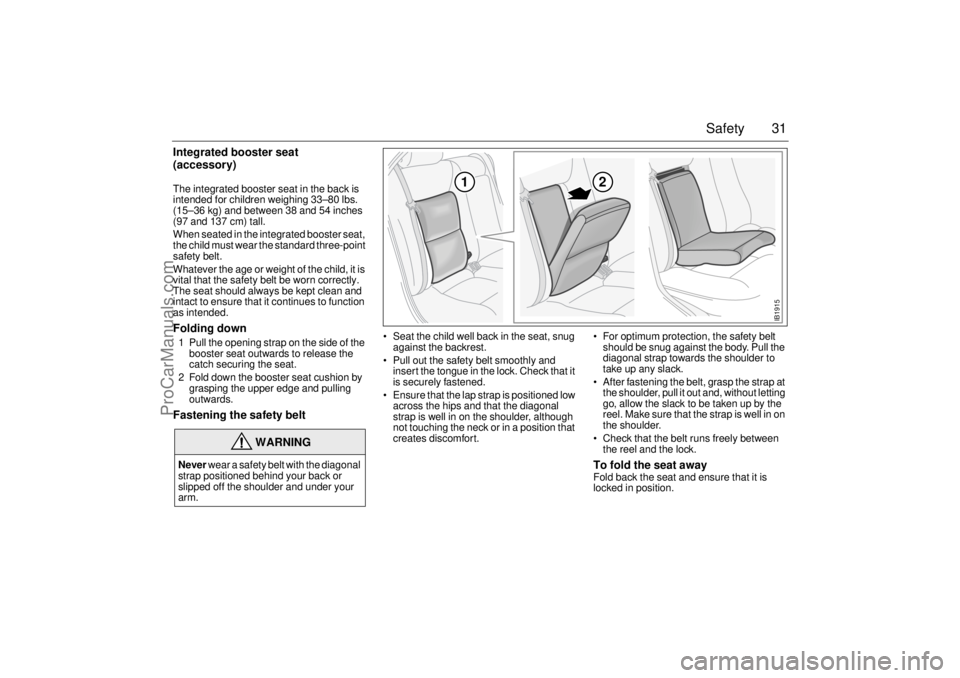
31 Safety
Integrated booster seat
(accessory)The integrated booster seat in the back is
intended for children weighing 33–80 lbs.
(15–36 kg) and between 38 and 54 inches
(97 and 137 cm) tall.
When seated in the integrated booster seat,
the child must wear the standard three-point
safety belt.
Whatever the age or weight of the child, it is
vital that the safety belt be worn correctly.
The seat should always be kept clean and
intact to ensure that it continues to function
as intended. Folding down 1 Pull the opening strap on the side of the
booster seat outwards to release the
catch securing the seat.
2 Fold down the booster seat cushion by
grasping the upper edge and pulling
outwards.Fastening the safety belt
Seat the child well back in the seat, snug
against the backrest.
Pull out the safety belt smoothly and
insert the tongue in the lock. Check that it
is securely fastened.
Ensure that the lap strap is positioned low
across the hips and that the diagonal
strap is well in on the shoulder, although
not touching the neck or in a position that
creates discomfort. For optimum protection, the safety belt
should be snug against the body. Pull the
diagonal strap towards the shoulder to
take up any slack.
After fastening the belt, grasp the strap at
the shoulder, pull it out and, without letting
go, allow the slack to be taken up by the
reel. Make sure that the strap is well in on
the shoulder.
Check that the belt runs freely between
the reel and the lock.
To fold the seat away Fold back the seat and ensure that it is
locked in position.
WARNING
Never wear a safety belt with the diagonal
strap positioned behind your back or
slipped off the shoulder and under your
arm.
IB1915
1
2
ProCarManuals.com
Page 32 of 288
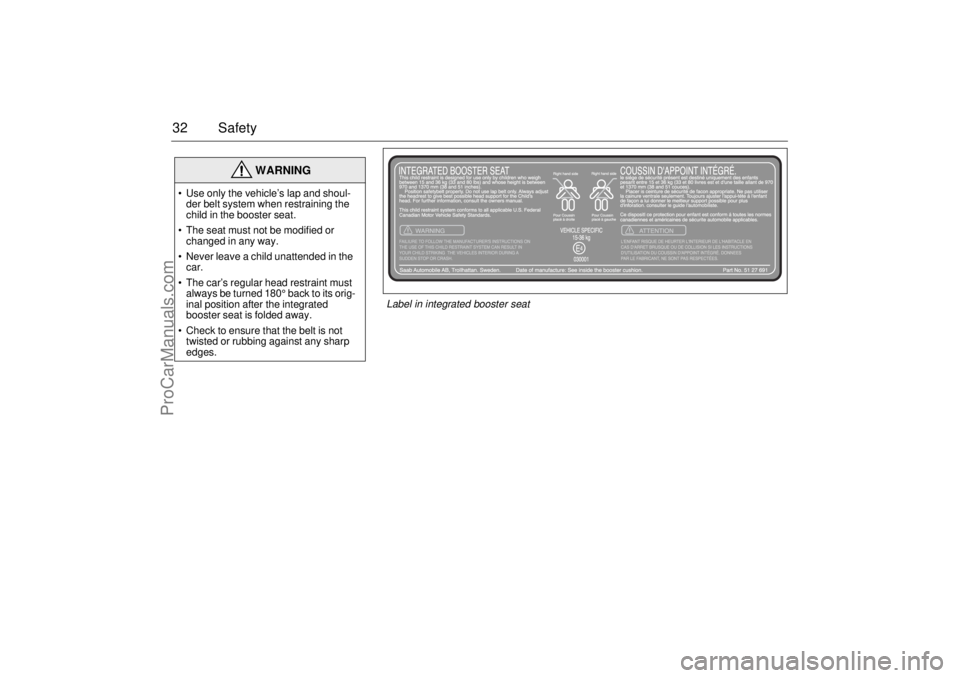
32 Safety
WARNING
Use only the vehicle’s lap and shoul-
der belt system when restraining the
child in the booster seat.
The seat must not be modified or
changed in any way.
Never leave a child unattended in the
car.
The car’s regular head restraint must
always be turned 180° back to its orig-
inal position after the integrated
booster seat is folded away.
Check to ensure that the belt is not
twisted or rubbing against any sharp
edges.
Label in integrated booster seat
ProCarManuals.com
Page 33 of 288
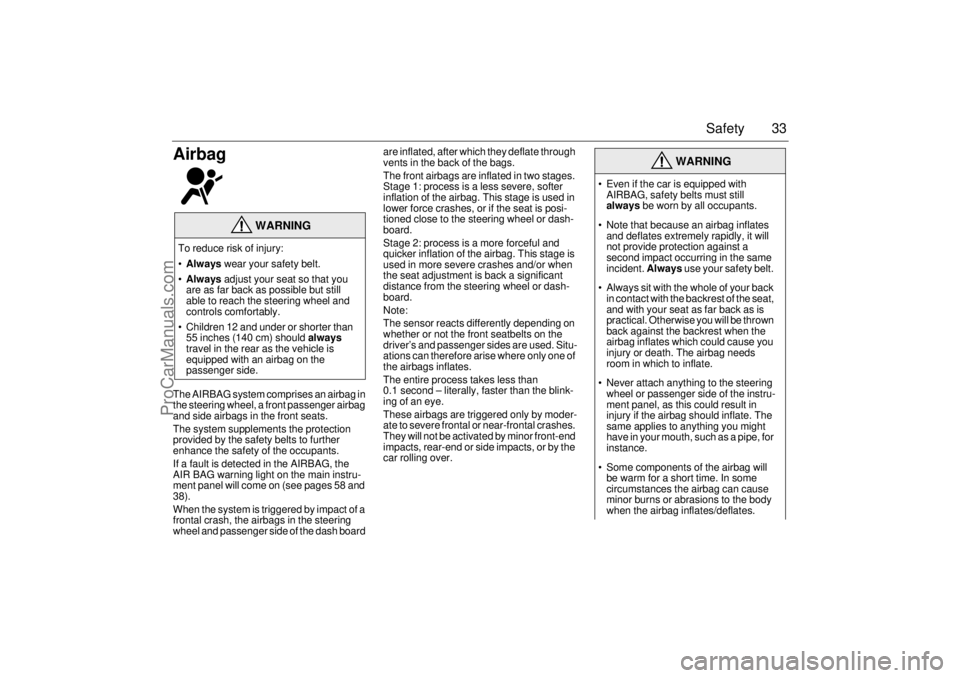
33 Safety
Airbag The AIRBAG system comprises an airbag in
the steering wheel, a front passenger airbag
and side airbags in the front seats.
The system supplements the protection
provided by the safety belts to further
enhance the safety of the occupants.
If a fault is detected in the AIRBAG, the
AIR BAG warning light on the main instru-
ment panel will come on (see pages 58 and
38).
When the system is triggered by impact of a
frontal crash, the airbags in the steering
wheel and passenger side of the dash board are inflated, after which they deflate through
vents in the back of the bags.
The front airbags are inflated in two stages.
Stage 1: process is a less severe, softer
inflation of the airbag. This stage is used in
lower force crashes, or if the seat is posi-
tioned close to the steering wheel or dash-
board.
Stage 2: process is a more forceful and
quicker inflation of the airbag. This stage is
used in more severe crashes and/or when
the seat adjustment is back a significant
distance from the steering wheel or dash-
board.
Note:
The sensor reacts differently depending on
whether or not the front seatbelts on the
driver’s and passenger sides are used. Situ-
ations can therefore arise where only one of
the airbags inflates.
The entire process takes less than
0.1 second – literally, faster than the blink-
ing of an eye.
These airbags are triggered only by moder-
ate to severe frontal or near-frontal crashes.
They will not be activated by minor front-end
impacts, rear-end or side impacts, or by the
car rolling over.
WARNING
To reduce risk of injury:
Always wear your safety belt.
Always adjust your seat so that you
are as far back as possible but still
able to reach the steering wheel and
controls comfortably.
Children 12 and under or shorter than
55 inches (140 cm) should always
travel in the rear as the vehicle is
equipped with an airbag on the
passenger side.
WARNING
Even if the car is equipped with
AIRBAG, safety belts must still
always be worn by all occupants.
Note that because an airbag inflates
and deflates extremely rapidly, it will
not provide protection against a
second impact occurring in the same
incident. Always use your safety belt.
Always sit with the whole of your back
in contact with the backrest of the seat,
and with your seat as far back as is
practical. Otherwise you will be thrown
back against the backrest when the
airbag inflates which could cause you
injury or death. The airbag needs
room in which to inflate.
Never attach anything to the steering
wheel or passenger side of the instru-
ment panel, as this could result in
injury if the airbag should inflate. The
same applies to anything you might
have in your mouth, such as a pipe, for
instance.
Some components of the airbag will
be warm for a short time. In some
circumstances the airbag can cause
minor burns or abrasions to the body
when the airbag inflates/deflates.
ProCarManuals.com
Page 34 of 288

34 Safety Never rest your hands or forearms on
the steering-wheel center padding.
If the AIR BAG warning light remains
on after the car has been started or
comes on while you are driving, have
the car checked immediately by an
authorized Saab dealer. The warning
light could signify that the airbags may
not inflate in a crash, or they could
even inflate without a crash. See
page. 58.
IB417Moment of impact.
The sensors detect
deceleration and send
a signal via the cen-
tral sensor to the gas
generator that inflates
the airbag.
The inflating airbag
cushions the driver.
Airbag now fully
inflated.
The airbag starts to
deflate.
IB419
Inflated airbag (driver side) Inflation and deflation together take less than
0.1 second.
ProCarManuals.com
Page 35 of 288
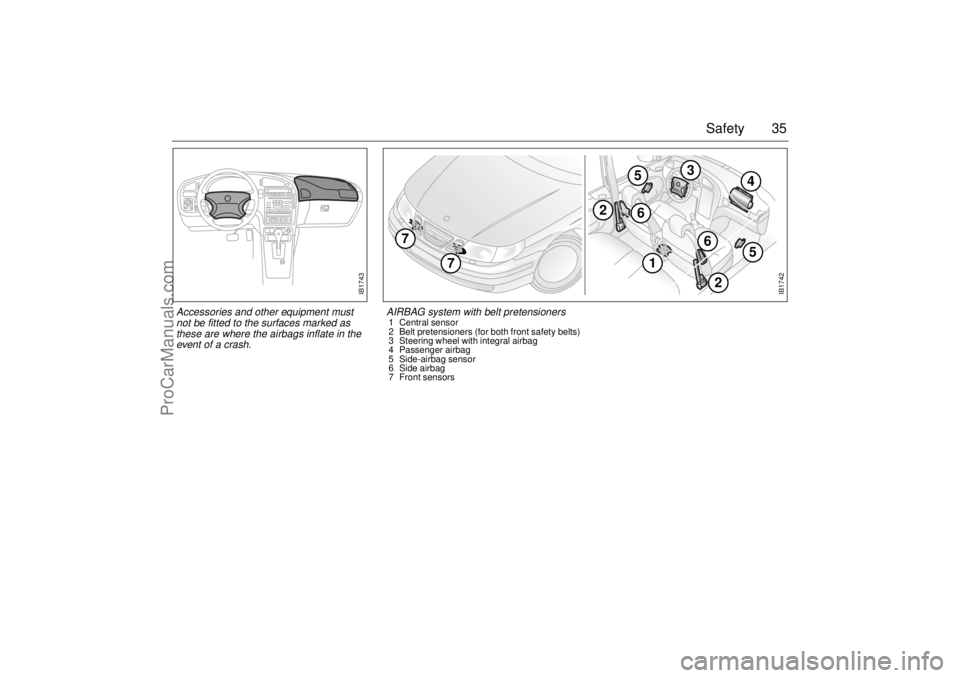
35 Safety
IB1742
5
1
4
2
6
3
2
6
7
7
5
AIRBAG system with belt pretensioners 1 Central sensor
2 Belt pretensioners (for both front safety belts)
3 Steering wheel with integral airbag
4 Passenger airbag
5 Side-airbag sensor
6 Side airbag
7 Front sensors
IB1743
Accessories and other equipment must
not be fitted to the surfaces marked as
these are where the airbags inflate in the
event of a crash.
ProCarManuals.com
Page 36 of 288
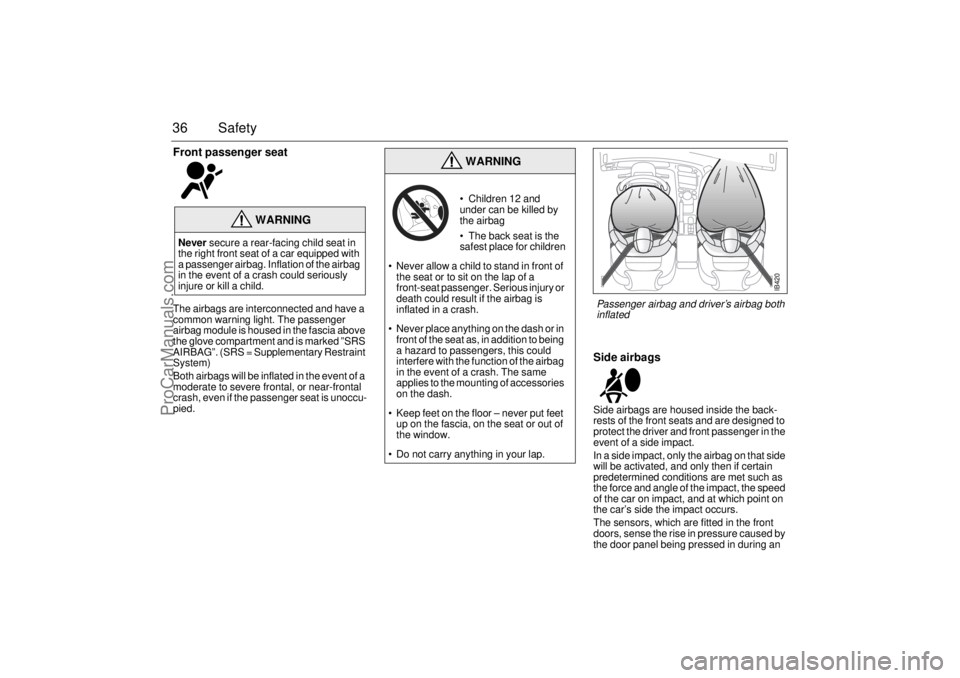
36 SafetyFront passenger seat The airbags are interconnected and have a
common warning light. The passenger
airbag module is housed in the fascia above
the glove compartment and is marked ”SRS
AIRBAG”. (SRS = Supplementary Restraint
System)
Both airbags will be inflated in the event of a
moderate to severe frontal, or near-frontal
crash, even if the passenger seat is unoccu-
pied.
Side airbags Side airbags are housed inside the back-
rests of the front seats and are designed to
protect the driver and front passenger in the
event of a side impact.
In a side impact, only the airbag on that side
will be activated, and only then if certain
predetermined conditions are met such as
the force and angle of the impact, the speed
of the car on impact, and at which point on
the car’s side the impact occurs.
The sensors, which are fitted in the front
doors, sense the rise in pressure caused by
the door panel being pressed in during an
WARNING
Never secure a rear-facing child seat in
the right front seat of a car equipped with
a passenger airbag. Inflation of the airbag
in the event of a crash could seriously
injure or kill a child.
WARNING Children 12 and
under can be killed by
the airbag
The back seat is the
safest place for children
Never allow a child to stand in front of
the seat or to sit on the lap of a
front-seat passenger. Serious injury or
death could result if the airbag is
inflated in a crash.
Never place anything on the dash or in
front of the seat as, in addition to being
a hazard to passengers, this could
interfere with the function of the airbag
in the event of a crash. The same
applies to the mounting of accessories
on the dash.
Keep feet on the floor – never put feet
up on the fascia, on the seat or out of
the window.
Do not carry anything in your lap.
IB420
Passenger airbag and driver’s airbag both
inflated
ProCarManuals.com
Page 37 of 288
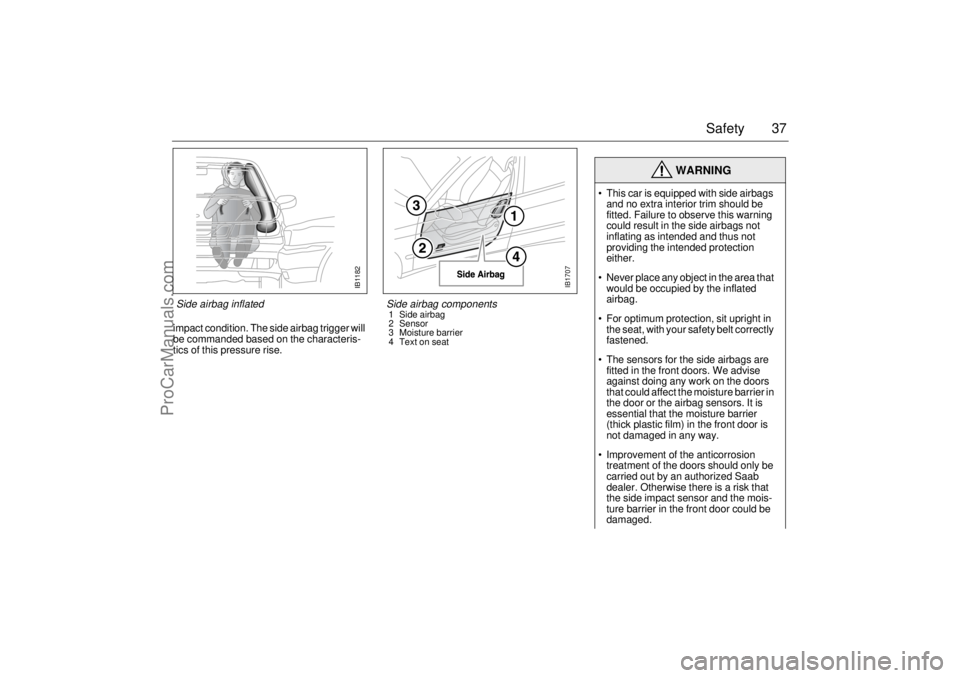
37 Safety
impact condition. The side airbag trigger will
be commanded based on the characteris-
tics of this pressure rise.
WARNING
This car is equipped with side airbags
and no extra interior trim should be
fitted. Failure to observe this warning
could result in the side airbags not
inflating as intended and thus not
providing the intended protection
either.
Never place any object in the area that
would be occupied by the inflated
airbag.
For optimum protection, sit upright in
the seat, with your safety belt correctly
fastened.
The sensors for the side airbags are
fitted in the front doors. We advise
against doing any work on the doors
that could affect the moisture barrier in
the door or the airbag sensors. It is
essential that the moisture barrier
(thick plastic film) in the front door is
not damaged in any way.
Improvement of the anticorrosion
treatment of the doors should only be
carried out by an authorized Saab
dealer. Otherwise there is a risk that
the side impact sensor and the mois-
ture barrier in the front door could be
damaged.
IB1182
Side airbag inflated
IB1707
Side airbag components 1 Side airbag
2 Sensor
3 Moisture barrier
4 Text on seat
ProCarManuals.com
Page 38 of 288
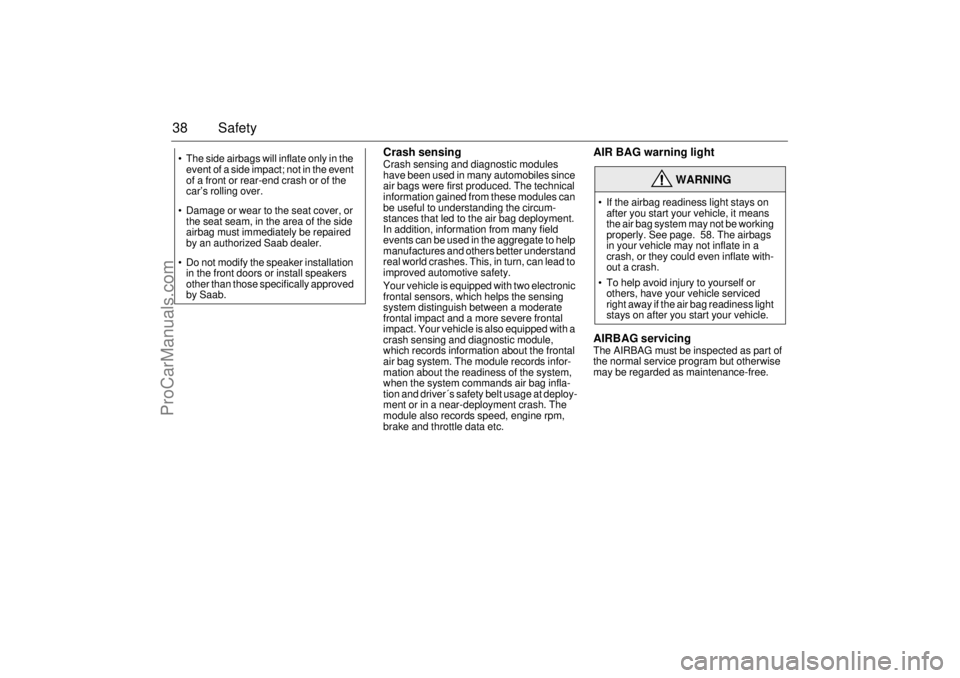
38 Safety
Crash sensingCrash sensing and diagnostic modules
have been used in many automobiles since
air bags were first produced. The technical
information gained from these modules can
be useful to understanding the circum-
stances that led to the air bag deployment.
In addition, information from many field
events can be used in the aggregate to help
manufactures and others better understand
real world crashes. This, in turn, can lead to
improved automotive safety.
Your vehicle is equipped with two electronic
frontal sensors, which helps the sensing
system distinguish between a moderate
frontal impact and a more severe frontal
impact. Your vehicle is also equipped with a
crash sensing and diagnostic module,
which records information about the frontal
air bag system. The module records infor-
mation about the readiness of the system,
when the system commands air bag infla-
tion and driver´s safety belt usage at deploy-
ment or in a near-deployment crash. The
module also records speed, engine rpm,
brake and throttle data etc.
AIR BAG warning light
AIRBAG servicingThe AIRBAG must be inspected as part of
the normal service program but otherwise
may be regarded as maintenance-free. The side airbags will inflate only in the
event of a side impact; not in the event
of a front or rear-end crash or of the
car’s rolling over.
Damage or wear to the seat cover, or
the seat seam, in the area of the side
airbag must immediately be repaired
by an authorized Saab dealer.
Do not modify the speaker installation
in the front doors or install speakers
other than those specifically approved
by Saab.
WARNING
If the airbag readiness light stays on
after you start your vehicle, it means
the air bag system may not be working
properly. See page. 58. The airbags
in your vehicle may not inflate in a
crash, or they could even inflate with-
out a crash.
To help avoid injury to yourself or
others, have your vehicle serviced
right away if the air bag readiness light
stays on after you start your vehicle.
ProCarManuals.com
Page 39 of 288

39 Safety
Scrapping or working on airbags
and belt pretensioners Frequently asked questions on func-
tion of airbags
Do you still need to wear a
safety b
elt if
airbags are fitted?
Yes, always! The airbag merely supple-
ments the car’s normal safety system.
Moreover, the airbag will only be actuated in
a moderate to severe frontal, or near-frontal
crash, which means, of course, that it
provides no protection in minor frontal
crashes, major rear-end or side-on crashes
or if the car rolls over.
The safety belts help reduce the chance of
the car occupants from being thrown around
and injured or killed inside the car.
But they also ensure that, if a crash occurs
in which the airbags are inflated, the airbag
will make the optimum contact with the
occupant, i.e. square on from the front. If the
occupant meets the airbag in an offset posi-
tion, the protection afforded will be reduced.
In addition, airbags provide no protection
against a secondary impact occurring in the
same incident. So there is no doubt about
the benefit of wearing safety belts at all
times.
Do not sit too close to the airbag: it needs
room to inflate.
The airbag inflates very quickly and power-
fully in order to protect an adult person,
before they are thrown forward, in a serious
frontal crash.
How do I position the seat to leave room for
the airbag to inflate?Don’t have your seat too far forward.
Recline the seat back to increase the
distance between you and the airbag. For
short drivers, special accessory pedal
extensions are available through your Saab
dealer.
Airbags inflate extremely rapidly and with
great force – to be fast enough to protect an
adult in the seat. When do the front airbags inflate? The airbag will only be inflated under certain
predetermined conditions in a moderate to
severe frontal, or near-frontal crash,
depending on such factors as the force and
angle of the impact, the speed of the car on
impact, and the resistance to deformation of
the impacting object.
The airbag can only be activated once in the
same incident.
Do not attempt to drive the car after an
airbag has been inflated, even if it is possi-
ble.
WARNING
Under no circumstances should any
modifications be made that affect the
steering wheel or the airbag’s electri-
cal circuitry.
Before starting any welding work on
the car, always disconnect the nega-
tive (–) battery lead and cover the
conductor.
Airbags and belt pretensioners must
be deployed under controlled condi-
tions before the car is scrapped or any
of the system’s components are
removed. Airbags or belt pretension-
ers that have been deployed as a
result of a crash must be replaced by
new ones.
Airbag-system components must
never be transferred for use in another
vehicle.
All work involving the scrapping or
replacement of airbags or belt preten-
sioners must only be carried out by
knowledgeable personnel.
ProCarManuals.com
Page 40 of 288

40 SafetyWhat won’t trigger the front airbags? The airbag will not be activated in all
front-end crashes. For instance, if the car
has hit something relatively soft and yielding
(e.g. a snow drift or a hedge) or a solid
object at a low impact speed, the airbag will
not necessarily be triggered. How loud is the inflation? The noise of the inflation is certainly loud,
but it is very short-lived and will not damage
your hearing. For a short time afterwards
you could experience a buzzing noise in
your ears.
Most people who have experienced it
cannot remember the noise of the inflation
at all – all they remember is the noise of the
crash. Can you still use a child seat in the front if a
passenger airbag is installed? Definitely not!
Children 12 and under can be injured or
killed by the airbag.
The BACK SEAT is the SAFEST place for
children.
NEVER put a child seat in the front.
Are the smoke and fumes given off when the
airbag operates at all harmful? Most people who have remained in a car
with little or no ventilation for several
minutes complained only of minor irritation
of the throat and eyes. Avoid as far as possi-
ble getting dust on your skin as there is a risk
of skin irritation.
If you suffer from asthma, the incident may
bring on an attack, in which case you should
follow the normal procedure advised by
your doctor. It is advisable to consult a
doctor afterwards.
What should I do if the AIR-BAG warning
light comes on? If the warning light is on, it means that a fault
has been detected in the system. The
airbag cannot be relied on to operate as
intended and it might even be activated
erroneously. You should therefore take the
car to an authorized Saab dealer as soon as
possible.
WARNING
When an airbag is inflated there is dust in
the air.
Because the dust/smoke can, in certain
cases, cause irritation to the skin, the
following precautions should be taken:
As soon as possible, wash any
exposed skin using a mild soap and
water.
If there is irritation of the eyes, flush
them liberally with clean water for at
least 20 minutes.
If this trouble persists, you should
consult a doctor.
WARNING
To reduce the risk of head injuries in the
event of a crash, the headliner and pillar
trims incorporate energy absorbing mate-
rial. These areas must not be modified in
any way. Work on these areas must only
be carried out at an authorized Saab
dealer.
ProCarManuals.com